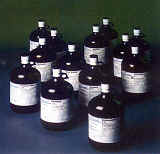
| 6. Coating Principles | |
|
6.6 Solvents |
|
Important Properties of Solvents
Good solvent power: It is more dependent on the polymer used than on the solvent itself. For example toluene has a good solvency for chlorinated rubber whereas white spirit is a poor solvent for it. Solvent retention affects the quantity of coating and makes it softer.
Viscosity: The higher the solvent power, the less the solvent needed to acquire a desired viscosity to maintain high solid content.
Ease of application: The solvent combination with a high evaporation ate may form dry mist during the application.
Drying: A slower evaporation rate is highly desirable to reduce all types of surface defects such as aeration of pinhole.
High flash point: Solvents with flash points lower than 23oC are inflammable and present fire risks.
Toxicity: Each solvent has its specified threshold limit value (TLV). It is a time weighed value defined as maximum allowable concentration (MAC) in parts per million. The concentration is given in cc per m3 of air. The lower the figure, the more toxic the solvent.

Thinners and solvents
Thinners
Thinners are solvents which are added to obtain the desired viscosity. The thinners must have the same solvency as the volatile element of the paint. The evaporation rate must be compatible with the application method. A combination of active solvent (primary solvent and a thinner) may provide stronger films.
|
|